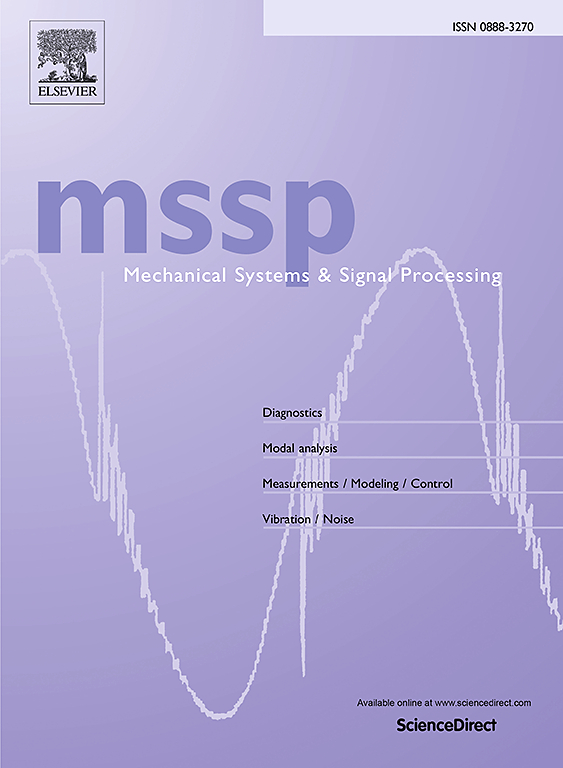物理诱导的太赫兹飞行时间补偿方法用于复合材料的精确厚度测量和损伤的全场成像
IF 7.9
1区 工程技术
Q1 ENGINEERING, MECHANICAL
引用次数: 0
摘要
准确、高效的损伤厚度估计和成像是评估服役复合材料结构完整性的关键。太赫兹(THz)技术作为一种先进的无损检测方法,在复合材料的定量表征方面显示出相当大的潜力。损伤厚度测量的主要挑战在于从测量的太赫兹信号中精确提取损伤的飞行时间(TOF)。然而,现有的TOF提取方法容易受到太赫兹信号中色散、重叠、多次反射和噪声等复杂干扰的影响,且性能受专家经验和损伤特征先验知识的限制。为了解决这些问题,本文提出了一种新的物理诱导太赫兹TOF补偿方法,用于复合材料的精确厚度测量和损伤的全场成像。该方法利用太赫兹波在受损区域和非受损区域的传播时差,从而减轻了人为干预和太赫兹信号干扰的影响。首先,建立了改进的太赫兹波在复合材料中的物理传播模型,以描述试样的起飞距离和表面均匀度对太赫兹测试性能的影响。随后,基于太赫兹波的传播特性,提出了太赫兹TOF补偿方法来准确估计损伤厚度。此外,提出了一种高分辨率的全场损伤成像方法,利用估计的损伤厚度来可视化复合材料结构的损伤分布。总的来说,该方法为太赫兹无损检测中各种复杂场景下的精确损伤厚度测量提供了新的见解,在复合材料的自动化和在线监测方面取得了重大进展。本文章由计算机程序翻译,如有差异,请以英文原文为准。
Physics induced terahertz time-of-flight compensation method for accurate thickness measurement and full-field imaging of damage in composite
Accurate and efficient damage thickness estimation and imaging are critical for assessing the structural integrity of composite in service. Terahertz (THz) technique, as an advanced nondestructive testing (NDT) method, has emerged considerable potentials in the quantitative characterization of composite materials. The primary challenge in damage thickness measurement lies in precisely extracting the time-of-flight (TOF) of damage from the measured THz signal. However, existing TOF extraction methods are susceptible to the complex interferences in THz signal such as dispersion, overlaps, multiple reflection, and noise, and the performance is limited by the expert experience and prior knowledge of damage characteristics. In this work, to address these limitations, a novel physics induced THz TOF compensation method is proposed for the accurate thickness measurement and full-field imaging of damage in composite. The method leverages the propagation time difference of THz wave through the damaged and non-damaged regions, and thereby mitigating the impact of the human interventions and THz signal interferences. Initially, the improved physical propagation model of THz wave in composite is established to describe the effects lift-off distance and surface evenness of sample on THz testing performance. Subsequently, the THz TOF compensation method is developed to accurately estimate the damage thickness based on THz propagation characteristic of THz wave. In addition, a high-resolution full-field damage imaging approach is proposed, utilizing the estimated damage thickness to visualize the damage distribution across the composite structure. Overall, the proposed method provides a novel insight for the accurate damage thickness measurement under various complex scenarios in THz NDT, offering significant advancements in the automation and online monitoring of composite materials.
求助全文
通过发布文献求助,成功后即可免费获取论文全文。
去求助
来源期刊

Mechanical Systems and Signal Processing
工程技术-工程:机械
CiteScore
14.80
自引率
13.10%
发文量
1183
审稿时长
5.4 months
期刊介绍:
Journal Name: Mechanical Systems and Signal Processing (MSSP)
Interdisciplinary Focus:
Mechanical, Aerospace, and Civil Engineering
Purpose:Reporting scientific advancements of the highest quality
Arising from new techniques in sensing, instrumentation, signal processing, modelling, and control of dynamic systems
 求助内容:
求助内容: 应助结果提醒方式:
应助结果提醒方式:


